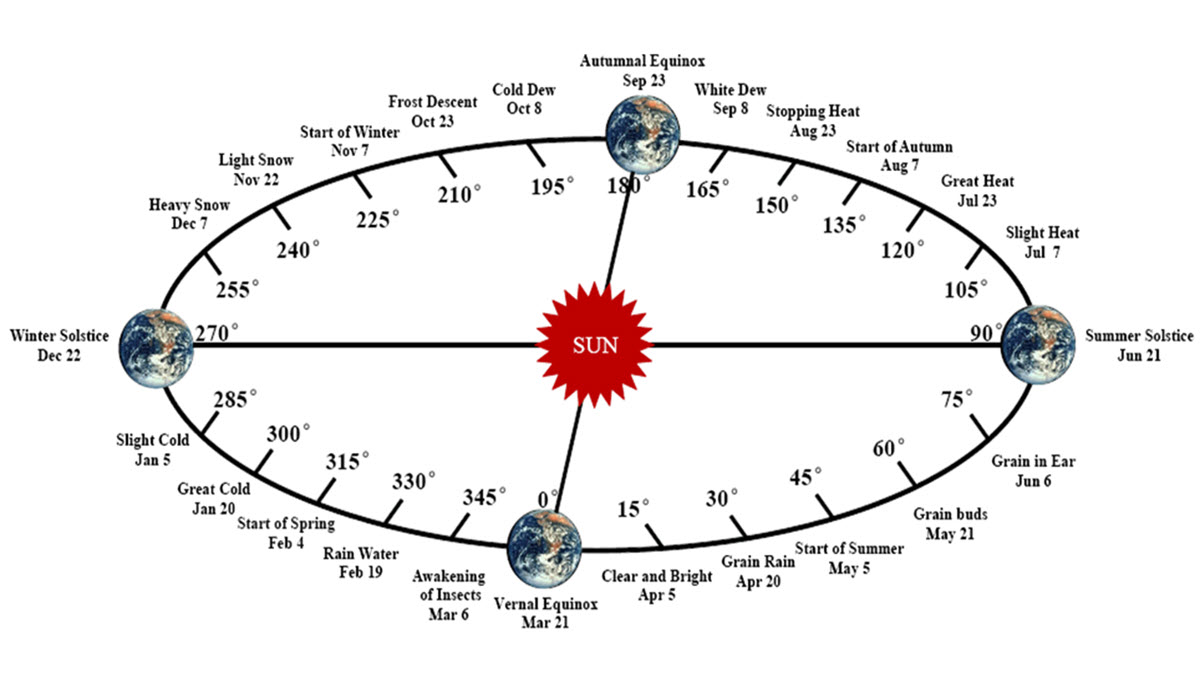“24 Chinese Solar Terms” is the correct translation for “24节气” in English. These terms represent the traditional Chinese way of dividing the year into 24 segments based on the sun’s position, marking the changes in seasons and weather throughout the year. They hold significant cultural and agricultural importance in China.
“24 Solar Terms” refer to the traditional Chinese way of dividing the year into 24 segments, reflecting seasonal changes and agricultural activities. These terms are evenly distributed throughout the year, occurring approximately every 15 days. Here is some common knowledge about the 24 Solar Terms:
1. **Names of the 24 Solar Terms**: The 24 Solar Terms, in order of appearance, include Beginning of Spring, Rain Water, Awakening of Insects, Vernal Equinox, Clear and Bright, Grain Rain, Beginning of Summer, Grain Buds, Grain in Ear, Summer Solstice, Minor Heat, Major Heat, Beginning of Autumn, End of Heat, White Dew, Autumnal Equinox, Cold Dew, Frost’s Descent, Beginning of Winter, Minor Snow, Major Snow, Winter Solstice, and Minor Cold.
2. **Reflecting Seasonal Changes**: The 24 Solar Terms reflect the changes in seasons and help farmers determine when to plant, harvest, and carry out other agricultural activities.
3. **Climatic Characteristics**: Each Solar Term has its own climatic characteristics. For example, the Beginning of Spring marks the start of spring, Major Heat represents the peak of summer, and Winter Solstice signifies the cold winter season.
4. **Cultural Significance**: The 24 Solar Terms are not only agriculturally significant but also deeply rooted in Chinese cultural traditions. Each term is associated with specific customs, legends, and celebrations.
5. **Seasonal Foods**: Each Solar Term is linked to traditional foods, such as eating green dumplings during Clear and Bright or dumplings during Winter Solstice. These foods reflect the cultural and climatic aspects of each term.
6. **Modern Applications**: While the 24 Solar Terms originated in an agricultural society, they are still observed and celebrated in modern times. They are also used in meteorological predictions and environmental conservation efforts.
In summary, the 24 Solar Terms constitute an important temporal system in Chinese culture, connecting people with nature and preserving the ancient traditions of agriculture.
Here is some common knowledge about the 24 Solar Terms:
1. 立春 (Lì Chūn) – Start of Spring
2. 雨水 (Yǔ Shuǐ) – Rain Water
3. 惊蛰 (Jīng Zhé) – Waking of Insects
4. 春分 (Chūn Fēn) – Spring Equinox
5. 清明 (Qīng Míng) – Clear and Bright
6. 谷雨 (Gǔ Yǔ) – Grain Rain
7. 立夏 (Lì Xià) – Start of Summer
8. 小满 (Xiǎo Mǎn) – Grain Full
9. 芒种 (Máng Zhòng) – Grain in Ear
10. 夏至 (Xià Zhì) – Summer Solstice
11. 小暑 (Xiǎo Shǔ) – Slight Heat
12. 大暑 (Dà Shǔ) – Great Heat
13. 立秋 (Lì Qiū) – Start of Autumn
14. 处暑 (Chù Shǔ) – Limit of Heat
15. 白露 (Bái Lù) – White Dew
16. 秋分 (Qiū Fēn) – Autumn Equinox
17. 寒露 (Hán Lù) – Cold Dew
18. 霜降 (Shuāng Jiàng) – Frost’s Descent
19. 立冬 (Lì Dōng) – Start of Winter
20. 小雪 (Xiǎo Xuě) – Slight Snow
21. 大雪 (Dà Xuě) – Great Snow
22. 冬至 (Dōng Zhì) – Winter Solstice
23. 小寒 (Xiǎo Hán) – Slight Cold
24. 大寒 (Dà Hán) – Great Cold
Time about the 24 Solar Terms:
**Spring:**
1. 立春 (Lìchūn) – Around February 4th
2. 雨水 (Yǔshuǐ) – Around February 18th
3. 惊蛰 (Jīngzhé) – Around March 5th
4. 春分 (Chūnfēn) – Around March 20th
5. 清明 (Qīngmíng) – Around April 4th
6. 谷雨 (Gǔyǔ) – Around April 19th
**Summer:**
7. 立夏 (Lìxià) – Around May 5th
8. 小满 (Xiǎomǎn) – Around May 21st
9. 芒种 (Mángzhòng) – Around June 6th
10. 夏至 (Xiàzhì) – Around June 21st
11. 小暑 (Xiǎoshǔ) – Around July 7th
12. 大暑 (Dàshǔ) – Around July 22nd
**Autumn:**
13. 立秋 (Lìqiū) – Around August 7th
14. 处暑 (Chǔshǔ) – Around August 23rd
15. 白露 (Báilù) – Around September 7th
16. 秋分 (Qiūfēn) – Around September 22nd
17. 寒露 (Hánlù) – Around October 8th
18. 霜降 (Shuāngjiàng) – Around October 23rd
**Winter:**
19. 立冬 (Lìdōng) – Around November 7th
20. 小雪 (Xiǎoxuě) – Around November 22nd
21. 大雪 (Dàxuě) – Around December 7th
22. 冬至 (Dōngzhì) – Around December 21st
23. 小寒 (Xiǎohán) – Around January 5th
24. 大寒 (Dàhán) – Around January 20th
These solar terms have special significance in the Chinese lunar calendar and reflect changes in weather and agriculture throughout the year. They have a long history and deep cultural significance in Chinese culture.
“Stay tuned for website updates; more little nuggets of knowledge await your exploration.”
Post time: Sep-12-2023









